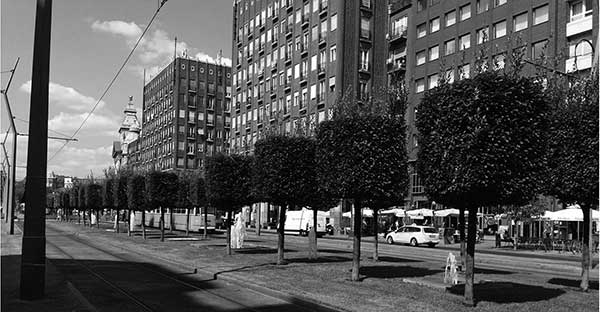Urban design through landscape architecture.
The Budapest case study
Keywords:
urban designAbstract
Hungarian Landscape architecture has become an independent discipline substantial in both the contemporary open space design and urban design in Hungary. Challenges of the global climate change, the issues of urban liveability and sustainable rainwater management, have played an inevitable role in self-definition and acknowledgment of the landscape architecture profession, same way as the changing of social context and sensitivity towards issues of environmental quality.
The advance of landscape architecture in Hungary is also due to the accession to the European Union un 2005. Thanks to a new economic and financial context, more attention is paid to the heritage conservation, sustainable and democratic use of existing values. As a result of all these changes, the improvement of urban spatial quality became a main development aspect of urban governance, and landscape architecture play an efficient tool in contemporary urban design.
Downloads
References
Balogh, P. I., Koszorú, L. & Mohácsi, S. (2008). From ordinary streets to main street. The new Main street program of central area of Pest. (pp. 4-17). Budapest, Hungary: 4D Tájépítészeti és Kertművészeti Folyóirat.
Bardóczi, S. (2009): Három vonal - három év. In: https://epiteszforum.hu/harom-vonal-harom-ev
Bardóczi, S. (2009): Körte korszak. In: https://epiteszforum.hu/korte-korszak
Bardóczi, S. & Dér, A. (eds) (2010). Tájodüsszeia. Katalógus a magyar tájépítész szakma 2000-2010 közötti legfontosabb alkotásaiból. Budapest, Hungary.
Bardóczi, S. (ed) (2015). Tájodüsszeia. Katalógus a magyar tájépítész szakma 2010-2015 közötti legfontosabb alkotásaiból. Budapest, Hungary.
Bukovszki, P. (2019). Formálódik a nemzet főtere In: http://pestbuda.hu/cikk/20190615_bukovszki_peter_javaban_zajlanak_a_kossuth_teri_epitkezesek
Cullen, G. (1971). The Concise Townscape. London, UK: The Architectural Press.
Fekete, A., Koszorú, L. & Zöldi, P. (2009). Budapest Szíve: Reprezentatív kaputérség – Károly Körút, Astoria csomópont, Deák Ferenc tér, Bajcsy Zsilinszky út, József Attila utca és kapcsolódó zöldfelületek megújítása. (pp. 3-13). Budapest, Hungary: 4D Tájépítészeti és Kertművészeti Folyóirat.
Fekete, A., Planchat, S., Szöbölödi, A. & Takács, D. (2012). Kortárs szabadtérépítészeti alkotások akadálymentességének elemzése Budapest belvárosában. In: A. Csemez (Ed.), Fenntartható fejlődés, élhető régió, élhető települési táj. 3. köt. (pp. 131-141). Budapest, Hungary: Budapesti Corvinus Egyetem.
Fiala, I. (2008). Építési engedélyezési terv szakbírálata, Tárgya: Budapest Szíve városfejlesztési program – Reprezentatív kaputérség kiépítése (Károly körút – Deák tér – József Attila utca közterületi megújítása. Budapest, 2008. december.
Francis, M (2003). Urban Open Space. Designing for users need. Land and Community design case study series, Landscape Architecture Foundation, Island Press, Washington-London.
Kovács, D. (2011): Így lesz KALEF a Moszkvából In: http://hg.hu/cikkek/varos/12639-igy-lesz-kalef-a-moszkvabol
Lukovich, T. (1993): Postmodern Streets: An urban design perspective, Ch. 9 in R. Freestone ed. Spirited Cities, The Federation Press, Sydney.
Lynch, K. (1988): The Image of the City, The MIT Press, Cambridge, Mass.
Marcus, C.C. & Francis, C. (1998): People spaces. Design Guideline for Urban Open Space. Dept of Architecture and Landscape Architecture, University of California, Berkeley.
Mumford, L. (1981) The Culture of Cities, Greenwood Press, Westport, Connecticut, USA.
Serf, D. (2019): A felújított Széll Kálmán tér In: https://epiteszforum.hu/a-felujitott-szell-kalman-ter
Viczián, Zs. (2016): Pest-budai vaktérkép, betonba öntve a Széll Kálmán téren. In: http://pestbuda.hu/cikk/20160322_pest_budai_vakterkep_betonba_ontve_a_szell_kalman_teren
Yang, Y., He, R., Ning, D., Wang, G., Liu, M., & Fekete, A. (2021). An Overview of Urban Park Development in Zhengzhou, China. Acta Biologica Marisiensis, 4(2), pp. 1-13.

Downloads
Published
How to Cite
Issue
Section
License
Copyright (c) 2022 Anales del Instituto de Arte Americano e Investigaciones Estéticas «Mario J. Buschiazzo»

This work is licensed under a Creative Commons Attribution-NonCommercial-ShareAlike 4.0 International License.



